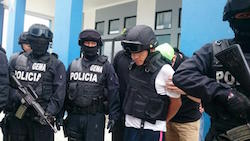Peruvian drug trafficker Gerald Oropeza, alias “Tony Montana,” was arrested on September 10, 2015, in Ecuador, a significant step for the police amongst Peru’s mixed success in targeting port-based narcotrafficking.
Oropeza is suspected of exporting large shipments of cocaine from El Callao port on the Peruvian coast to Europe, Central America and Mexico. He also allegedly has ties to Italy’s ‘Ndrangheta criminal group.
Oropeza had been on the run for five months after authorities issued an order for his arrest on April 20, 2015, following an attack on Oropeza’s vehicle, the result of a feud with a suspected drug trafficker named Gerson Galvez.
After his arrest by a joint operation between Ecuadorian and Peruvian police, Oropeza was reportedly deported back to Peru. Oropeza will be transferred to a maximum-security prison in Lima, according to El Comercio, where he will be held prior to his trial.
InSight Crime Analysis
The arrest of Gerald Oropeza serves as an important reminder of the key role that seaports, especially El Callao, play in Peru’s international drug trade, and the need for Peruvian forces to pay as much attention to criminal dynamics in the ports as they are to rebel-controlled cocaine production areas in the mountains.
SEE ALSO: Peru News and Profiles
Peru’s antinarcotics forces have focused recent efforts primarily on aerial trafficking, the principal method for drug export from the country. The military has taken steps to stop aerial trafficking by destroying remote airstrips, especially in the VRAEM region, where much of Peru’s cocaine is produced and where part of the Shining Path guerrillas operate.
In August 2015, Peru’s congress unanimously approved legislation that allows the military to shoot down suspected drug planes. This controversial tactic has been implemented in attempts to stem aerial trafficking.
At the same time, though, antinarcotics forces have done little to tackle drug trafficking through Peru’s seaports. An investigation conducted by La Republica demonstrated how criminal groups and corrupt officials collaborate to smuggle hundreds of tons of cocaine through El Callao every year.
Criminal networks, including Oropeza’s group, have also been involved in ongoing feuds over control of El Callao port, highlighting its importance to Peru’s international drug trade.

